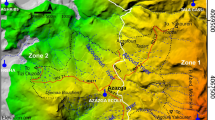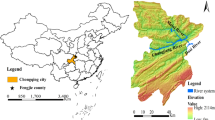Abstract
The application of landslide hazard model coupled with GIS provides an effective means to spatial hazard analysis and prediction on rainfall-induced landslides. A modified SINMAP model is established based upon the systematic investigation on previous GIS-based landslide analysis models. By integrating the landslide deterministic model with the hydrological distribution model based on DEM, this model deeply studied the effect of underground water distribution due to rainfall on the slope stability and landslide occurrence, including the effect of dynamic water pressure resulting from the down slope seepage process as well as that of static water pressure. Its applicability has been testified on the Xiaojiang watershed, the rainfall-induced landslides widespread area in Southeast China. Detailed discussion was carried out on the spatial distribution characteristics of landslide hazard and its extending trend, as well as the quantitative relationship between landslide hazard with precipitation, slope angle and specific catchment area in the Xiaojiang watershed. And the precipitation threshold for landslide occurrence was estimated. These analytical results are proved useful for geohazard control and engineering decision-making in the Xiaojiang watershed.
Similar content being viewed by others
References
Wen, B. P., The state of the art and trend of the landslide prediction, Earth Science Frontiers (in Chinese), 1996, 3(1–2): 86–92.
Yin, K. L., Yan, T. Z., Landslide prediction and related models, Chinese Journal of Rock Mechanics and Engieering (in Chinese), 1996, 15(1): 1–8.
Sun, G. Z., Yao, B. K., Landslide hazard in China and its research, (ed. Chinese Society of Rock Mechanics and Engineering) Typical landslides in China (in Chinese), Beijing: Science Press, 1988, 1–11.
Carrara, A., Guzzetti, F., Use of GIS technology in the prediction and monitoring of landslide hazard, Natural Hazards, 1999, 20(2): 117–135.
Guzzetti, F., Carrara, A., Cardinali, M. et al., Landslide evaluation: a review of current techniques and their application in a multi-scale study, Central Italy, Geomorphology, 1999, 31: 181–216.
Pike, R. J., Quantifying landslide-terrain types from digital elevation models, Mathematical Geology, 1988, 20(5): 491–511.
Carrara, A., Cardinali, M., Guzzetti, F. et al., GIS technology in mapping landslide hazard (eds. Carrara, A., Guzzetti, F.), Geographical Information Systems in Assessing Natural Hazards, Dordrecht: Kluwer Academic Publishers, 1995, 135–175.
Carrara, A., Multivariate methods for landslide hazard evaluation, Mathematical Geology, 1983, 15: 403–426.
Chung, C. F., Fabbri, A. G., Van Westen, C. J., Multivariate regression analysis for landslide hazard zonation (eds. Carrara, A., Guzzetti, F.), Geographical Information Systems in Assessing Natural Hazards, Dordrecht: Kluwer Academic Publishers, 1995, 107–133.
Heckerman, Probabilistic interpretation of MYCIN’s certainty factors (eds. Kanal, L. N., Lemmer, J. E.), Uncertainty in Artificial Intelligence, New York: Elsevier, 1986, 298–311.
Chung, C. F., Fabbri, A. G., Probabilistic prediction models for landslide hazard mapping, Photogrammetric Engineering & Remote Sensing (PE&RS), 1999, 65(12): 1388–1399.
Montgomery, D. R., Dietrich, W. E., A physically based model for the topographic control on shallow landsliding, Water Resources Research, 1994, 30(4): 1153–1171.
Dietrich, E. W., Reisss, R., Hsu, M. L. et al., A process-based model for colluvial soil depth and shallow landsliding using digital elevation data, Hydrological Processes, 1995, 9: 383–400.
Wu, W., Sidle, R. C., A distributed slope stability model for steep forested watersheds, Water Resources Research, 1995, 31(8): 2097–2110.
Chung, C. F., Fabbri, A. G., Prediction models for landslide hazard using fuzzy set approach (eds. Marchetti, M., Rivas, V.), Geomorphology and Environmental Impact Assessment, Rotterdam: A. A. Balkema Publisher, 2001, 31–47.
Binaghi, E., Luzi, L., Madella, P., Slope instability zonation: a comparison between certainty factor and fuzzy Dempster-Shafer approaches, Natural Hazards, 1998, 17: 77–97.
Zhou, C. H., Lee, C. F., Li, J., On the spatial relationship between landslides and causative factors on Lantau Island, Hong Kong. Geomorphology, 2002, 43: 197–207.
Pack, R. T., Tarboton, D. G., Goodwin, C. N. The SINMAP approach to terrain stability mapping, Proceedings of 8th Congress of the International Assocation of Engineering Geology (eds. Moore, D., Hungr, O.), Rotterdam, A. A. Balema Publisher, 1998, 1157–1165.
Du, R. H., Kang, Z. C., Chen, X. Q. et al., Synthetic Investigation and control on the debris flow in the Xiaojiang watershed, Yunnan (in Chinese), Chongqing: Science Technology Press, 1987, 57–71.
Wu, J. S., Kang, Z. C., Tian, L. Q. et al., Observation on the Debris Flow in Jiangjiagou, Yunnan (in Chinese), Beijing: Science Press, 1990, 26–47.
Author information
Authors and Affiliations
About this article
Cite this article
Lan, H., Wu, F., Zhou, C. et al. Spatial hazard analysis and prediction on rainfall-induced landslide using GIS. Chin.Sci.Bull. 48, 703–708 (2003). https://doi.org/10.1007/BF03325659
Received:
Accepted:
Published:
Issue Date:
DOI: https://doi.org/10.1007/BF03325659




